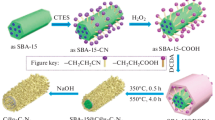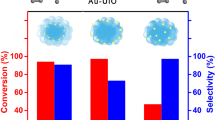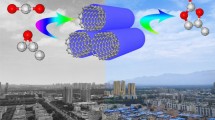Abstract
Carbon-carbon (C-C) coupling reactions represent one of the most powerful tools for the synthesis of complex natural products, bioactive molecules developed as drugs and agrochemicals. In this work, a multifunctional nanoreactor for C-C coupling reaction was successfully fabricated via encapsulating the core-shell Cu@Ni nanocubes into ZIF-8 (Cu@Ni@ZIF-8). In this nanoreactor, Ni shell of the core-shell Cu@Ni nanocubes was the catalytical active center, and Cu core was in situ heating source for the catalyst by absorbing the visible light. Moreover, benefiting from the plasmonic resonance effect between Cu@Ni nanocubes encapsulated in ZIF-8, the absorption range of nanoreactor was widened and the utilization rate of visible light was enhanced. Most importantly, the microporous structure of ZIF-8 provided shape-selective of reactant. This composite was used for the highly shape-selective and stable photocatalysed C-C coupling reaction of boric acid under visible light irradiation. After five cycles, the nanoreactor still remained high catalytical activity. This Cu@Ni@ZIF-8 nanoreactor opens a way for photocatalytic C-C coupling reactions with shape-selectivity.

Similar content being viewed by others
References
Khusnutdinova, J. R.; Rath, N. P.; Mirica, L. M. The aerobic oxidation of a Pd(II) dimethyl complex leads to selective ethane elimination from a Pd(III) intermediate. J. Am. Chem. Soc.2012, 134, 2414–2422.
Shahabi Nejad, M.; Seyedi, N.; Sheibani, H.; Behzadi, S. Synthesis and characterization of Ni(II) complex functionalized silica-based magnetic Nanocatalyst and its application in C-N and C-C cross-coupling reactions. Mol. Divers.2019, 23, 527–539.
Zhang, S.; Li, J.; Gao, W.; Qu, Y. Q. Insights into the effects of surface properties of oxides on the catalytic activity of Pd for C-C coupling reactions. Nanoscale2015, 7, 3016–3021.
Kumar, R.; van der Eycken, E. V. Recent approaches for C-C bond formation via direct dehydrative coupling strategies. Chem. Soc. Rev.2013, 42, 1121–1146.
Chen, X.; Engle, K. M.; Wang, D. H.; Yu, J. Q. Palladium(II)-catalyzed C-H activation/C-C cross-coupling reactions: Versatility and practicality. Angew. Chem., Int. Ed.2009, 48, 5094–5115.
Choi, M.; Lee, D. H.; Na, K.; Yu, B. W.; Ryoo, R. High catalytic activity of palladium(II)-exchanged mesoporous sodalite and NaA zeolite for bulky aryl coupling reactions: Reusability under aerobic conditions. Angew. Chem., Int. Ed.2009, 48, 3673–3676.
Guerra, J.; Herrero, M. A. Hybrid materials based on Pd nanoparticles on carbon nanostructures for environmentally benign C-C coupling chemistry. Nanoscale2010, 2, 1390–1400.
Youn, S. W.; Kim, B. S.; Jagdale, A. R. Pd-catalyzed sequential C-C bond formation and cleavage: Evidence for an unexpected generation of arylpalladium(II) species. J. Am. Chem. Soc.2012, 134, 11308–11311.
Wang, D. H.; Mei, T. S.; Yu, J. Q. Versatile Pd(II)-catalyzed C-H activation/aryl-aryl coupling of benzoic and phenyl acetic acids. J. Am. Chem. Soc.2008, 130, 17676–17677.
Ishizuka, K.; Seike, H.; Hatakeyama, T.; Nakamura, M. Nickel-catalyzed alkenylative cross-coupling reaction of alkyl sulfides. J. Am. Chem. Soc. 2010, 132, 13117–13119.
Khusnutdinova, J. R.; Rath, N. P.; Mirica, L. M. Stable mononuclear organometallic Pd(III) complexes and their C-C bond formation reactivity. J. Am. Chem. Soc.2010, 132, 7303–7305.
Velian, A.; Lin, S. B.; Miller, A. J. M.; Day, M. W.; Agapie, T. Synthesis and C-C coupling reactivity of a dinuclear Ni’-Ni1 complex supported by a terphenyl diphosphine. J. Am. Chem. Soc.2010, 132, 6296–6297.
Kim, K.; Jung, Y.; Lee, S.; Kim, M.; Shin, D.; Byun, H.; Cho, S. J.; Song, H.; Kim, H. Directed C-H activation and tandem cross-coupling reactions using palladium nanocatalysts with controlled oxidation. Angew. Chem., Int. Ed.2017, 56, 6952–6956.
Lan, G. X.; Quan, Y.; Wang, M. L.; Nash, G. T.; You, E.; Song, Y.; Veroneau, S. S.; Jiang, X. M.; Lin, W. B. Metal-organic layers as multifunctional two-dimensional nanomaterials for enhanced photoredox catalysis. J. Am. Chem. Soc.2019, 141, 15767–15772.
Chakraborty, I. N.; Roy, S.; Devatha, G.; Rao, A.; Pillai, P. P. InP/ZnS quantum dots as efficient visible-light photocatalysts for redox and carbon-carbon coupling reactions. Chem. Mater.2019, 31, 2258–2262.
Yu, S. J.; Wilson, A. J.; Heo, J.; Jain, P. K. Plasmonic control of multi-electron transfer and C-C coupling in visible-light-driven CO2 reduction on Au nanoparticles. Nano Lett.2018, 18, 2189–2194.
Wang, X. N.; Wang, F. L.; Sang, Y. H.; Liu, H. Full-spectrum solar-light-activated photocatalysts for light-chemical energy conversion. Adv. EnergyMater.2017, 7, 1700473.
Neaţu, S.; Maciá-Agulló, J. A.; Concepción, P.; Garcia, H. Gold-copper nanoalloys supported on TiO2 as photocatalysts for CO2 reduction by water. J. Am. Chem. Soc.2014, 136, 15969–15976.
Kisch, H. Semiconductor photocatalysis—mechanistic and synthetic aspects. Angew. Chem., Int. Ed.2013, 52, 812–847.
Chen, H. R.; Shen, K.; Chen, J. Y.; Chen, X. D.; Li, Y. W. Hollow-ZIF-templated formation of a ZnO@C-N-Co core-shell nanostructure for highly efficient pollutant photodegradation. J. Mater. Chem. A2017, 5, 9937–9945.
Sheng, H. B.; Chen, D. Y.; Li, N. J.; Xu, Q. F.; Li, H.; He, J. H.; Lu, J. M. Urchin-inspired TiO2@MIL-101 double-shell hollow particles: Adsorption and highly efficient photocatalytic degradation of hydrogen sulfide. Chem. Mater.2017, 29, 5612–5616.
Pang, X. B.; Chang, W.; Chen, C. C.; Ji, H. W.; Ma, W. H.; Zhao, J. C. Determining the TiO2-photocatalytic aryl-ring-opening mechanism in aqueous solution using oxygen-18 labeled O2 and H2O. J. Am. Chem. Soc.2014, 136, 8714–8721.
Yang, Q. H.; Xu, Q.; Yu, S. H.; Jiang, H. L. Pd nanocubes@ZIF-8: Integration of plasmon-driven photothermal conversion with a metal-organic framework for efficient and selective catalysis. Angew. Chem., Int. Ed.2016, 128, 3749–3753.
Li, Z. X.; Yu, C. C.; Wen, Y. Y.; Gao, Y.; Xing, X. F.; Wei, Z. T.; Sun, H.; Zhang, Y. W.; Song, W. Y. Mesoporous hollow Cu-Ni alloy nanocage from core-shell Cu@Ni Nanocube for efficient hydrogen evolution reaction. ACS Catal.2019, 9, 5084–5095.
Kale, M. J.; Avanesian, T.; Christopher, P. Direct photocatalysis by plasmonic nanostructures. ACS Catal.2014, 4, 116–128.
Chen, J. X.; Feng, J.; Yang, F.; Aleisa, R.; Zhang, Q.; Yin, Y. D. Space-confined seeded growth of Cu nanorods with strong surface plasmon resonance for photothermal actuation. Angew. Chem., Int. Ed.2019, 58, 9275–9281.
Kazuma, E.; Yamaguchi, T.; Sakai, N.; Tatsuma, T. Growth behaviour and plasmon resonance properties of photocatalytically deposited Cu nanoparticles. Nanoscale2011, 3, 3641–3645.
Wang, F. F.; Huang, Y. J.; Chai, Z. G.; Zeng, M.; Li, Q.; Wang, Y.; Xu, D. S. Photothermal-enhanced catalysis in core-shell plasmonic hierarchical Cu7S4 microsphere@zeolitic imidazole framework-8. Chem. Sci.2016, 7, 6887–6893.
Wang, M. M.; Tang, Y. F.; Jin, Y. D. Modulating catalytic performance of metal-organic framework composites by localized surface plasmon resonance. ACS Catal.2019, 9, 11502–11514.
Yin, Z.; Wang, Y.; Song, C. Q.; Zheng, L. H.; Ma, N.; Liu, X.; Li, S. W.; Lin, L. L.; Li, M. Z.; Xu, Y. et al. Hybrid Au-Ag nanostructures for enhanced plasmon-driven catalytic selective hydrogenation through visible light irradiation and surface-enhanced Raman scattering. J. Am. Chem. Soc.2018, 140, 864–867.
Zhang, H. B.; Wang, T.; Wang, J. J.; Liu, H. M.; Dao, T. D.; Li, M.; Liu, G. G.; Meng, X. G.; Chang, K.; Shi, L. et al. Surface-plasmonenhanced photodriven CO2 reduction catalyzed by metal-organic-framework-derived iron nanoparticles encapsulated by ultrathin carbon layers. Adv. Mater.2016, 28, 3703–3710.
Atay, T.; Song, J. H.; Nurmikko, A. V. Strongly interacting plasmon nanoparticle pairs: From dipole-dipole interaction to conductively coupled regime. Nano Lett.2004, 4, 1627–1631.
DuChene, J. S.; Tagliabue, G.; Welch, A. J.; Li, X. Q.; Cheng, W. H.; Atwater, H. A. Optical excitation of a nanoparticle Cu/p-NiO photocathode improves reaction selectivity for CO2 reduction in aqueous electrolytes. Nano Lett.2020, 20, 2348–2358.
Schünemann, S.; Dodekatos, G.; Tüysüz, H. Mesoporous silica supported Au and AuCu nanoparticles for surface plasmon driven glycerol oxidation. Chem. Mater.2015, 27, 7743–7750.
Chen, S.; Tang, F.; Tang, L. Z.; Li, L. D. Synthesis of Cu-nanoparticle hydrogel with self-healing and photothermal properties. ACS Appl. Mater. Interfaces2017, 9, 20895–20903.
Dong, L. L.; Ji, G. M.; Liu, Y.; Xu, X.; Lei, P. P.; Du, K. M.; Song, S. Y.; Feng, J.; Zhang, H. J. Multifunctional Cu-Ag2S nanoparticles with high photothermal conversion efficiency for photoacoustic imaging-guided photothermal therapy in vivo. Nanoscale2018, 10, 825–831.
Zhou, M.; Zhang, R.; Huang, M.; Lu, W.; Song, S. L.; Melancon, M. P.; Tian, M.; Liang, D.; Li, C. A chelator-free multifunctional [64Cu]CuS nanoparticle platform for simultaneous micro-PET/CT imaging and photothermal ablation therapy. J. Am. Chem. Soc.2010, 132, 15351–15358.
Tian, Q. W.; Hu, J. Q.; Zhu, Y. H.; Zou, R. J.; Chen, Z. G.; Yang, S. P.; Li, R. W.; Su, Q. Q.; Han, Y.; Liu, X. G. Sub-10 nm Fe3O4@Cu2-xS core-shell nanoparticles for dual-modal imaging and photothermal therapy. J. Am. Chem. Soc.2013, 135, 8571–8577.
Zhang, Y. J.; Sha, R.; Zhang, L.; Zhang, W. B.; Jin, P. P.; Xu, W. G.; Ding, J. X.; Lin, J.; Qian, J.; Yao, G. Y. et al. Harnessing copper-palladium alloy tetrapod nanoparticle-induced pro-survival autophagy for optimized photothermal therapy of drug-resistant Cancer. Nat. Commun.2018, 9, 4236.
Chen, L. Y.; Peng, Y.; Wang, H.; Gu, Z. Z.; Duan, C. Y. Synthesis of Au@ZIF-8 single- or multi-core-shell structures for photocatalysis. Chem. Commun.2014, 50, 8651–8654.
Kuo, C. H.; Tang, Y.; Chou, L. Y.; Sneed, B. T.; Brodsky, C. N.; Zhao, Z. P.; Tsung, C. K. Yolk-shell nanocrystal@ZIF-8 nanostructures for gas-phase heterogeneous catalysis with selectivity control. J. Am. Chem. Soc.2012, 134, 14345–14348.
Wang, C. L.; Tuninetti, J.; Wang, Z.; Zhang, C.; Ciganda, R.; Salmon, L.; Moya, S.; Ruiz, J.; Astruc, D. Hydrolysis of ammonia-borane over Ni/ZIF-8 nanocatalyst: High efficiency, mechanism, and controlled hydrogen release. J. Am. Chem. Soc.2017, 139, 11610–11615.
Fu, F. Y.; Wang, C. L.; Wang, Q.; Martinez-Villacorta, A. M.; Escobar, A.; Chong, H. B.; Wang, X.; Moya, S.; Salmon, L.; Fouquet, E. et al. Highly selective and sharp volcano-type synergistic Ni2Pt@ZIF-8-catalyzed hydrogen evolution from ammonia borane hydrolysis. J. Am. Chem. Soc.2018, 140, 10034–10042.
Li, D. D.; Yu, S. H.; Jiang, H. L. From UV to near-infrared light-responsive metal-organic framework composites: Plasmon and upconversion enhanced photocatalysis. Adv. Mater.2018, 30, 1707377.
Liu, C.; Cao, C. Y.; Liu, J.; Wang, X. S.; Zhu, Y. N.; Song, W. G. One methyl group makes a major difference: Shape-selective catalysis by zeolite nanoreactors in liquid-phase condensation reactions. J. Mater. Chem. A2017, 5, 17464–17469.
Li, Y. D.; Ruan, Z. H.; He, Y. Z.; Li, J. Z.; Li, K. Q.; Jiang, Y. Q.; Xu, X. Z.; Yuan, Y.; Lin, K. F. In situ fabrication of hierarchically porous G-C3N4 and understanding on its enhanced photocatalytic activity based on energy absorption. Appl. Catal. B Environ.2018, 236, 64–75.
Zhou, L.; Tan, Y. L.; Wang, J. Y.; Xu, W. C.; Yuan, Y.; Cai, W. S.; Zhu, S. N.; Zhu, J. 3D self-assembly of aluminium nanoparticles for plasmon-enhanced solar desalination. Nat. Photonics2016, 10, 393–398.
Acknowledgements
We gratefully acknowledge the financial support from the Beijing Natural Science Foundation (No. 2182061) and Science Foundation of China University of Petroleum, Beijing (No. 2462019BJRC001).
Author information
Authors and Affiliations
Corresponding authors
Electronic Supplementary Material
Rights and permissions
About this article
Cite this article
Li, Z., Gong, Y., Zhang, X. et al. Plasmonic coupling-enhanced in situ photothermal nanoreactor with shape selective catalysis for C-C coupling reaction. Nano Res. 13, 2812–2818 (2020). https://doi.org/10.1007/s12274-020-2933-3
Received:
Revised:
Accepted:
Published:
Issue Date:
DOI: https://doi.org/10.1007/s12274-020-2933-3




